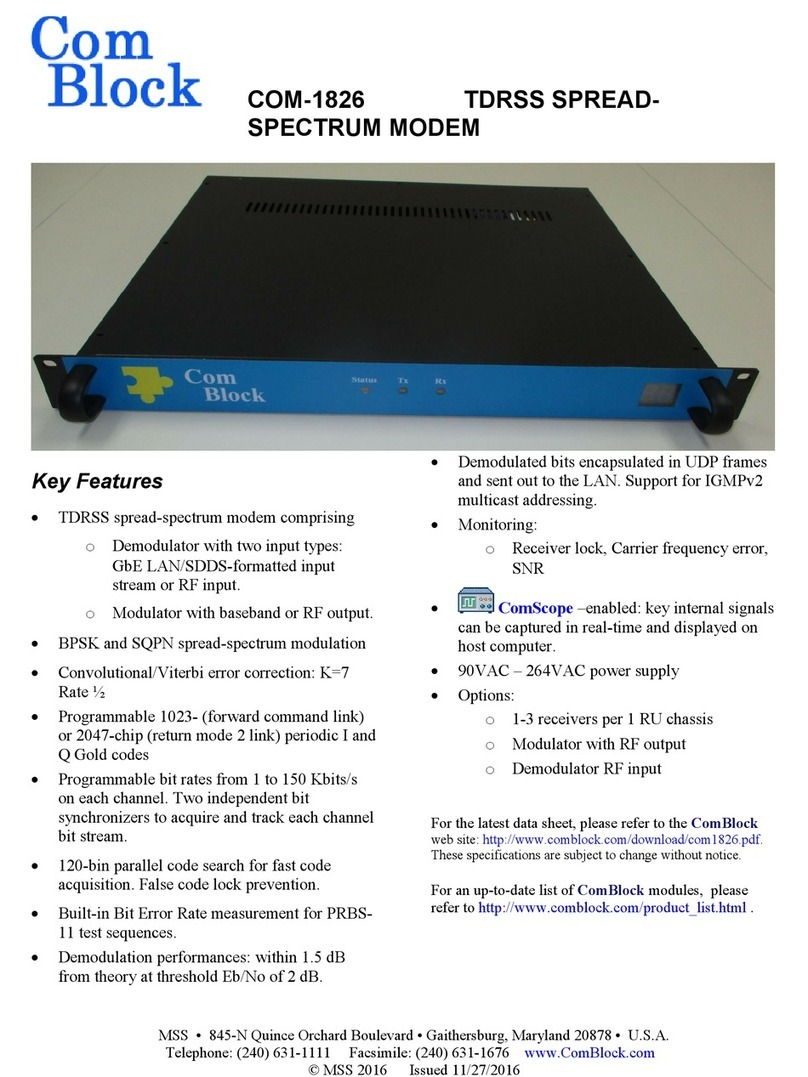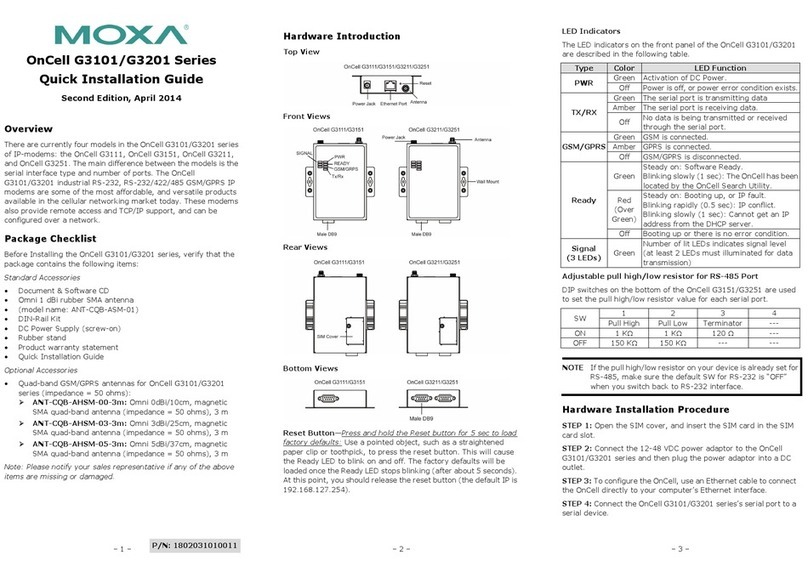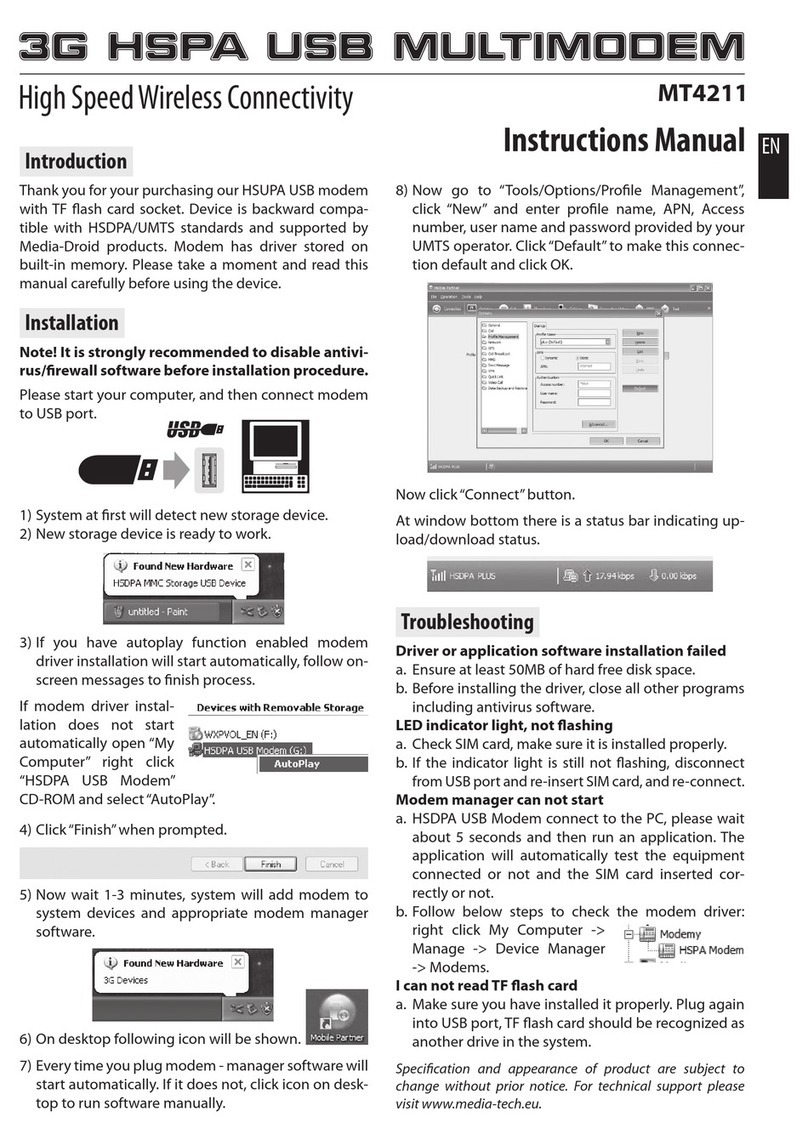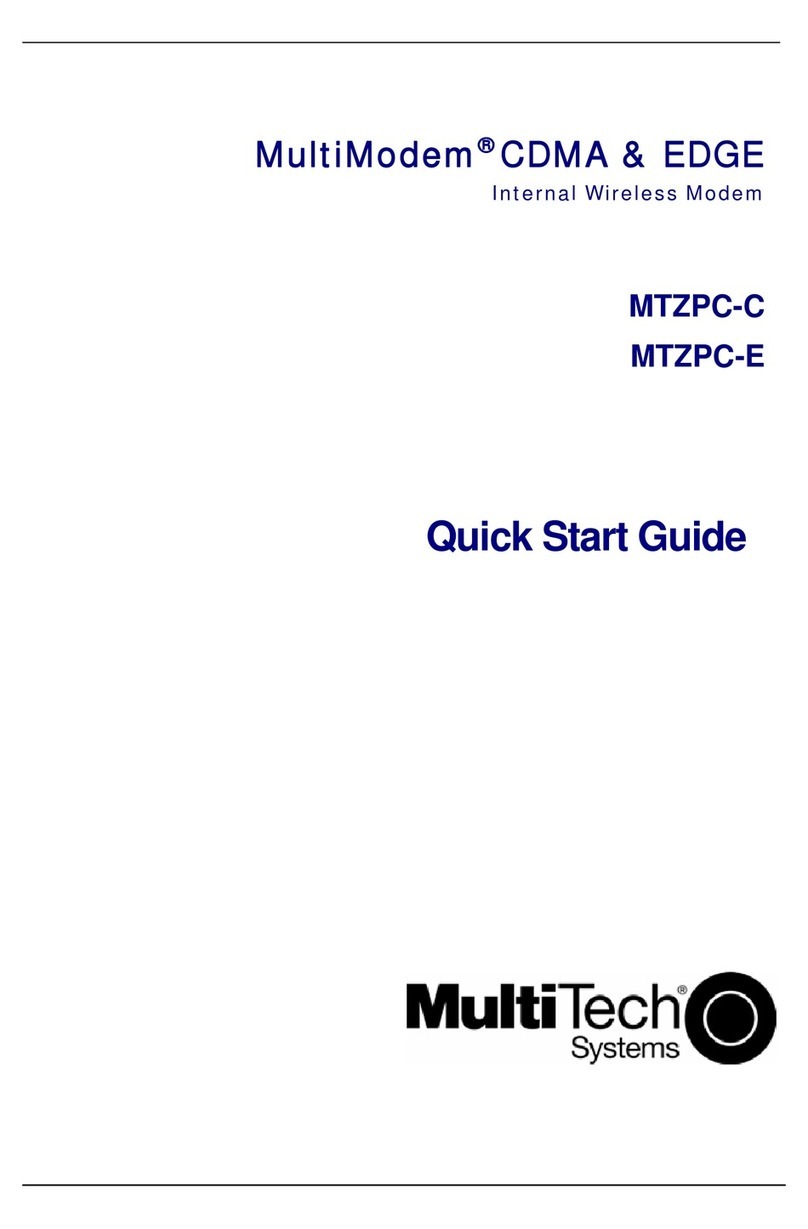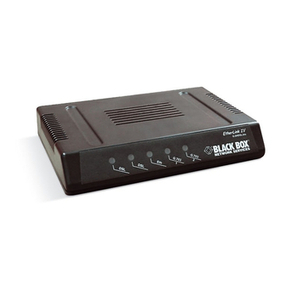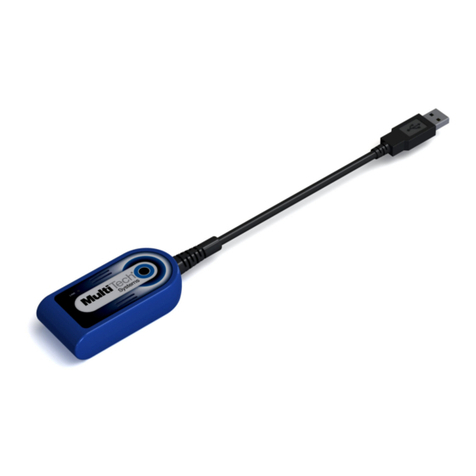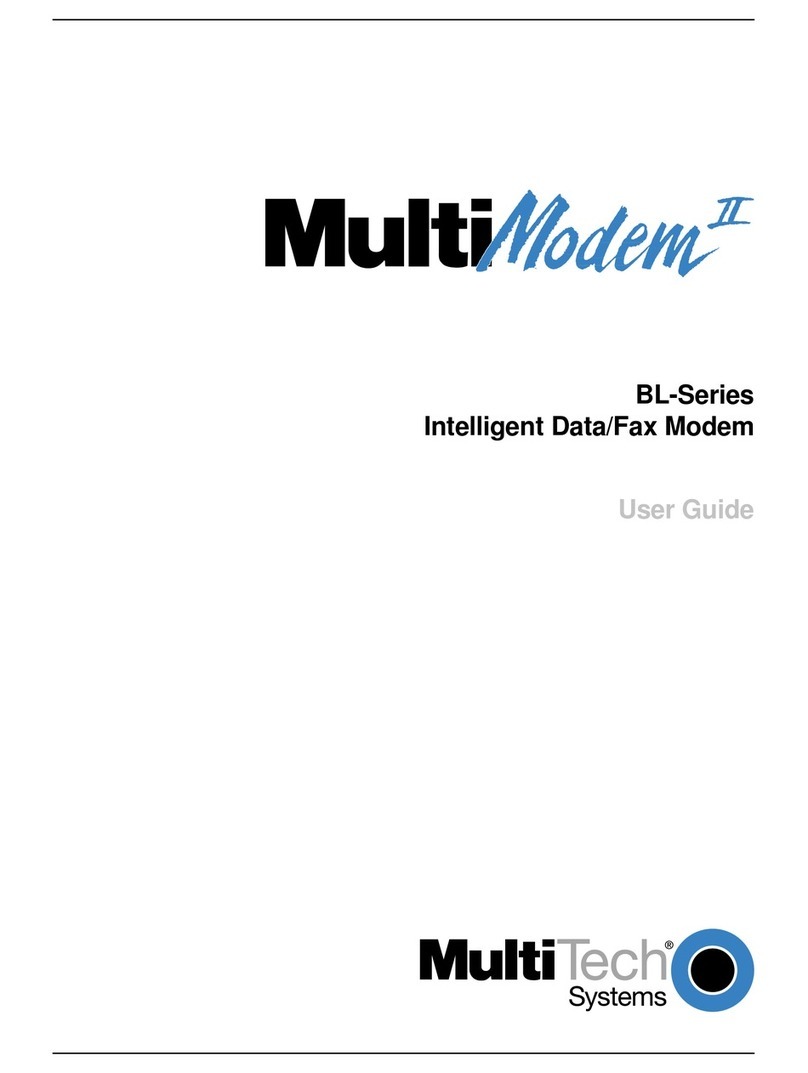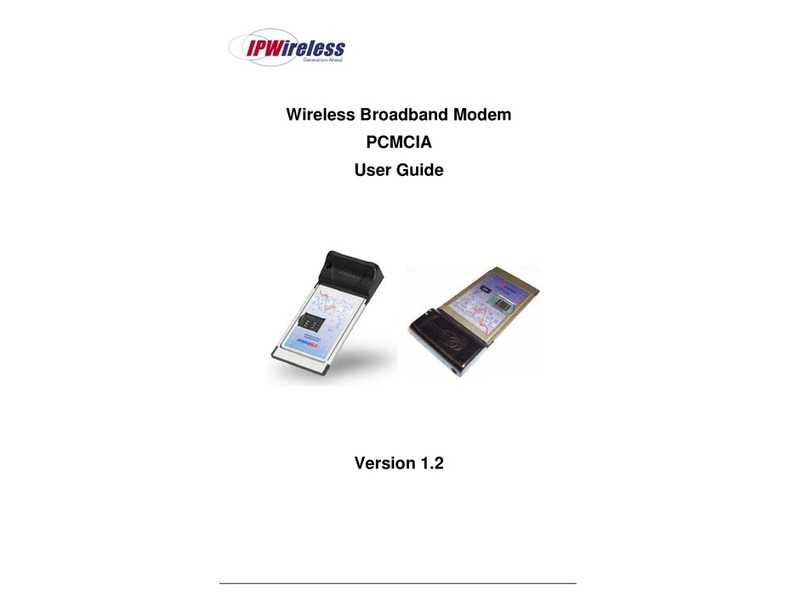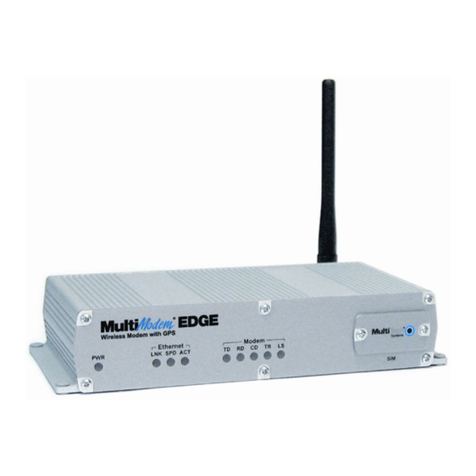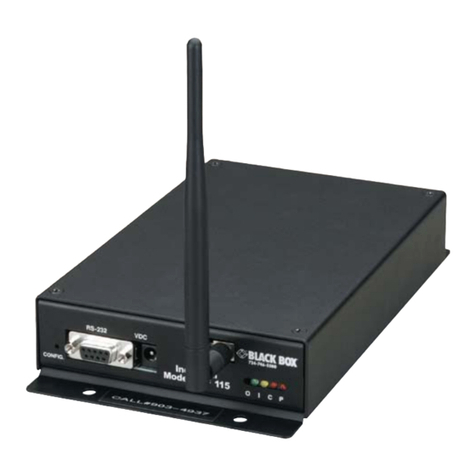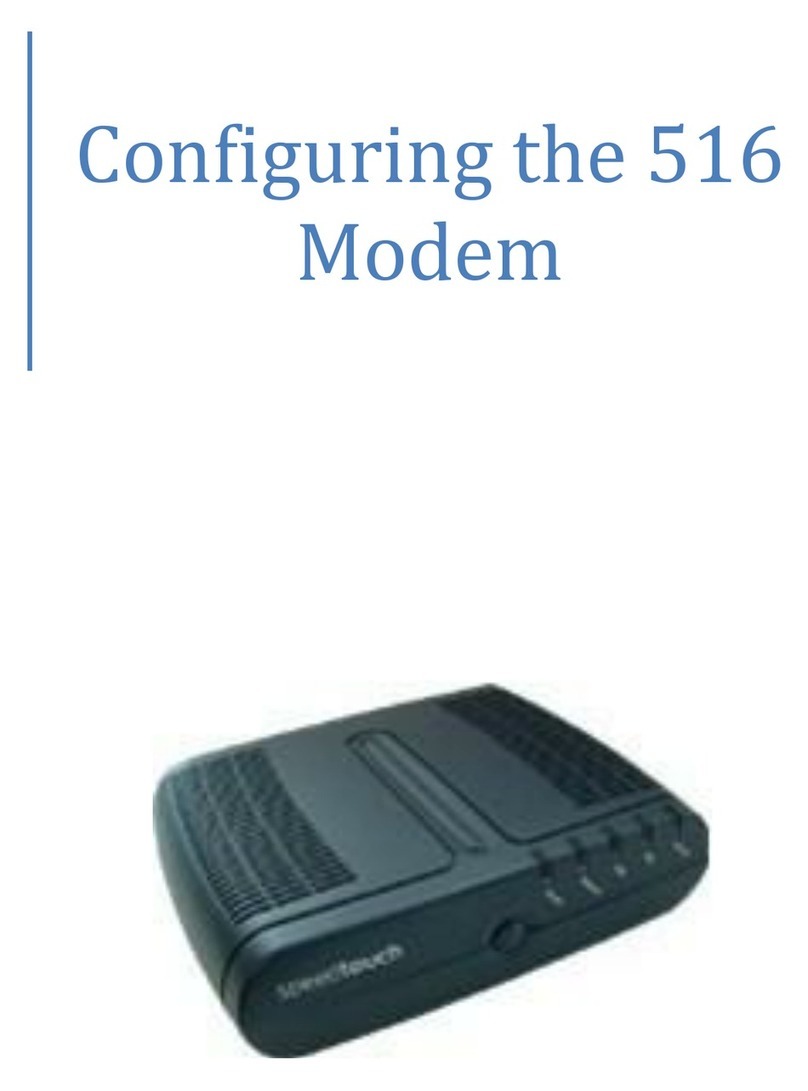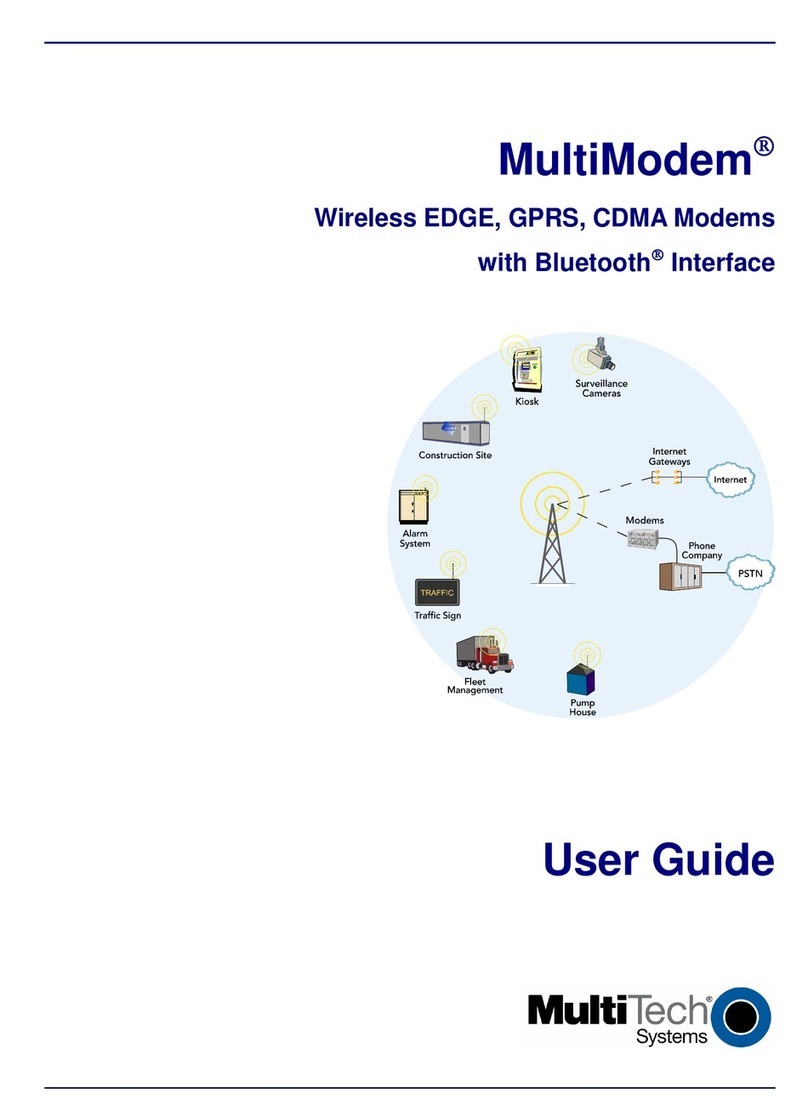Data-Linc Group PlantLinc PLR5000 User manual

USER GUIDE
I
NDUSTRIAL
D
ATA
C
OMMUNICATIONS
It is essential that all instructions contained in the User Guide are followed precisely to ensure proper operation of equipment.
IndustrialFrequencyHopping
SpreadSpectrumRadioModem
PlantLinc™
5000
PLR5000

DATA-LINC GROUP
PN 161-09888-001
Product User Guide
FCC Notification
This device complies with part 15 of the FCC rules. Operation is subject to the following conditions:
1) This devicemaynotcause harmfulinterference and
2) This devicemust acceptanyinterference received,including interferencethat may
causeundesired operation.
The device must be operated as supplied by Data-Linc Group.Any changes or modifications made to the
devicewithoutthe expresswritten approvalof Data-LincGroupmay voidthe user’sauthority tooperatethe
device.
Caution: This device has a maximum transmitted output power of 200 mW. It is required that the
transmit antenna be kept at least 23 cm away from nearby persons to satisfy FCC RF exposure
requirements.
Note: This equipment has been tested and found to comply with the limits for a ClassAdigital device, pursuant
topart15 ofthe FCCRules. These limitsare designedto provide reasonableprotection againstharmful
interferencein a industrialinstallation. Thisequipment generates,uses and canradiate radiofrequency energy
and, if not installed and used in accordance with the instructions, may cause harmful interference to radio
communications.However, thereis no guaranteethat interferencewill not occurin aparticular installation.If
thisequipmentdoes causeharmful interferenceto radio ortelevision reception,which canbedetermined by
turning the equipment off and on, the user is encouraged to try to correct the interference by one or more of the
followingmeasures:
Reorientor relocatethe receivingantenna.
Increasethe separationbetween theequipmentand receiver.
Connect the equipment into an outlet on a circuit different from that to which the receiver is connected.
Consultthe dealer oran experiencedradio/TV technicianfor help.
Note: WheneveranyData-Linc GroupPLR seriesmodemis placedinside anenclosure a labelmust beplaced
on the outside of that enclosure which includes the modem’s FCC ID.
Thefollowing antennasare approvedforuse withData-Linc Group’s900 MHzseries modems.
NOTE: Per FCC Rules, the maximum power allowed at the antenna is 4 Watts E.I.R.P.
900MHz Directional Antenna
Gain Manufacturer Manufacture Model Number Data-Linc Model Number
8.2 dBi Larsen YA6-900W A-YB
12.2 dBi Larsen YA0006 A-Y10B
900MHz Omni-Directional Antenna
Gain Manufacturer Manufacture Model Number Data-Linc Model Number
5.2 dBi Maxrad MAX-9053 A-OB
7.2 dBi Maxrad BMEFC8985HD A-O5B
0 dBi Ying Hao YH920801/AD-725-A-1 A-06/ADJ
0 dBi Centurion EXC-902-BN A-06BH-3S / 10S (**)
(**) This part number refers to an antenna kit(s). The 0 dBi refers to the antenna portion of the kit.
Note: The antenna used for this device must be professionally installed on a fixed-mounted permanent
outdoor structure for satisfying RF exposure requirements, including antenna co-location requirements
of1.1307(b)(3).

PlantLinc PLR5000 User’s Guide
P/N 161-09888-001 DATA-LINC Group 1
Table of Contents
Page
Introduction ..................................................................................................................................3
Loop Back Bench Test.................................................................................................................3
PLR5000 Modem Configuration...................................................................................................5
Main Menu Option (0): Set Operation Mode .......................................................................6
Main Menu Option (1): Set Baud Rate ................................................................................8
Main Menu Option (2): Edit Call Book.................................................................................9
Main Menu Option (3): Edit Radio Transmission Characteristics......................................12
Main Menu Option (4): Show Radio Statistics...................................................................16
Main Menu Option (5): Edit Multipoint Parameters ...........................................................18
Using an External Antenna ........................................................................................................21
Modem Front Panel LEDs..........................................................................................................22
Sample Data Communication Links...........................................................................................23
Technical Specifications ............................................................................................................25
Troubleshooting .........................................................................................................................26
Technical Support ......................................................................................................................28
Return Material Authorization ....................................................................................................28
Contact Information....................................................................................................................28
Appendix A: PLR5000 Modem Enclosure Diagram ...................................................................29

PlantLinc PLR5000 User’s Guide
P/N 161-09888-001 DATA-LINC Group 2

PlantLinc PLR5000 User’s Guide
P/N 161-09888-001 DATA-LINC Group 3
Introduction
The PLR5000 transceiver modems are high performance wireless radio modems designed for heavy-duty
industrial data communications in the 902-928 MHz license-free band. It employs advanced spread spectrum
frequency hopping and error detection technology to achieve very reliable, noise and interference immune
operation. An RF data rate of 38.4 Kbps and superior sensitivity provide ultra reliable data integrity at data
rates from 1200 to 38.4 Kbps. Full duplex operation at data rates up to 19.2 Kbps provide the fast response
times needed for polling communications. The PLR5000 has a range of up to 4 miles (6.5 km) with line-of-
sight and an omni directional antenna.
The PLR5000 can be operated in a number of different modes to satisfy a broad range of communications
requirements. It can be configured for point-to-point or multipoint operation with a unlimited number of
remote sites on a single Master depending on data throughput requirements. Repeaters can be used in the
system to eliminate dead RF zones that are blocked by obstructions.
External antennas can be used with up to one hundred feet of coax. With external antennas, radio modems can
be located inside buildings or metallic enclosures.
The PLR5000 will operate in virtually any environment where RS232 data communications are required. The
transceiver RS232 interface is a standard DB9-F connector that is configured for Data Communications
Equipment (DCE) operation. The PLR5000 will connect with a straight through RS232 cable to a device
configured for Data Terminal Equipment (DTE) operation.
The user guide covers the operating modes and configurations that are available to users of the PLR5000. It
also provides the user with bench testing instructions, technical information and specifications for the
PLR5000.
In most applications, the PLR5000 radios come from Data-Linc Group pre-configured for the application in
which they are going to be used. Generally, no other configuration is required. If you are unsure if the modem
needs further configuration, please contact Data-Linc Group.
Loop Back Bench Test
This procedure provides a simple and easy demonstration of proper operation of the Data-Linc Group
PLR5000 radio modems. The Loop Back Bench Test should be conducted to ensure system functionality
prior to actual installation, and to allow the installer to become familiar with operation of the radio modems.
A few minutes on the bench can save time in the field.
1.The PLR5000 radios that you have received are typically pre-configured by Data-Linc Group to
function as a system. No changes in configuration should be made with out first consulting the factory.
2.Attach the bench test antenna included with the radio modem.
3.Locate the PLR5000 labeled “MASTER.” Using a standard RS232 cable, connect the radio modem to a
communication port on a computer that has a communications utility such as HyperTerminal, ProComm
Plus or Terminal for Win3.x. Set the data rate (BPS) of the terminal program to match the port rate of the
PLR5000 Plug the power supply into an AC outlet of the correct voltage, and connect the power supply to
the PLR5000. The red LED marked “P” (power) on the radio modem front panel should turn on.

PlantLinc PLR5000 User’s Guide
P/N 161-09888-001 DATA-LINC Group 4
4.If your system is configured to use a Repeater(s), find the PLR5000(s) marked “REPEATER,” and
connect its power supply as with the Master above. The red LED marked “P” (power) on the radio
modem should turn on. If your system does not have a Repeater, skip this step.
5.Locate the PLR5000(s) labeled “REMOTE.” Connect the power supply to the PLR5000. The red LED
marked “P” (power) on the “REMOTE” radio modem should turn on. If it is a point-to-point system the
amber LED “C” (carrier detect) should turn on for both the Remote and Master. If it is a point-to-
multipoint system the “C” LED will turn on for the Remote only. Attach a Loop Back Test Jumper on the
RS232 data DB9F connector of the PLR5000 remote. The jumper shorts pins 2 and 3 of the data
connector.
6.Using the terminal that is connected to the “MASTER” PLR5000, hold down a key, “A” for example.
The letter “A” should begin to scroll across the terminal screen. This indicates that the data (the letter “A”
in this case) is being transmitted from the terminal through the “MASTER” PLR5000. Then through the
“REPEATER” (if applicable), on to the “REMOTE” PLR5000, through the Loop Back Test Jumper, back
through the “REPEATER” (if applicable) to the “MASTER,” and then the terminal. This establishes that
the PLR5000s are functioning in full duplex mode and are operating properly. Note: If something appears
scrolling across the terminal screen other than the correct character for the key being pressed, it indicates
that the terminal’s settings and data rate may not be set to match that of the PLR5000.
7.While continuing to press the letter “A,” the yellow LED marked “I” (Input) and the green LED marked
“O” (Output) should both be flashing rapidly on the Master radio modem and the Remote with the jumper
attached. Remove the jumper from the “REMOTE” radio modem. The letter display scrolling across the
screen should stop, and the “O” LED will stop flashing at the “MASTER.” The “I” LED will flash each
time the key is pressed; indicating that the radio modem is receiving a data input signal on the RS232
port. The “O” LED on the “REMOTE” will flash each time a key is pressed; indicating that the radio
modem is outputting a data input signal on the RS232 port. The “I” LED on the “REMOTE” will remain
off with no data Loop Back . Replace the Loop Back Test Jumper in the “REMOTE” radio modem. Hold
down the key again, and the letter should once again scroll across the computer screen. If there is a
“REPEATER” in the system its “C” (carrier detect) LED will flash rapidly when data is being passed.
The “REPEATER” “I” and “O” LED’s remain off during normal operation.
Repeat steps 5 through 7 with each of the “REMOTE” units for your system.
Data-Linc Group strongly recommends that once these tests have been successfully completed, all devices
that will be used in the system (PLC, RTU, software, computers, etc.) be connected to the system and bench
tested to assure full functionality before final installation. If the radios will not function in the system on the
bench, remove the radio modems from the system and confirm that the equipment will communicate with a
direct hard wire link. If the devices will not communicate directly without the radio modems, then they will
not communicate with them. The radio modems emulate a direct asynchronous communication link.
Once the preceding bench tests have established that the system is fully functional, site installation should
proceed. However, before connecting the entire system hardware, Data-Linc Group recommends that steps 3
through 7 above be performed on-site to confirm radio modem operation and adequate line of sight between
the antennas.

PlantLinc PLR5000 User’s Guide
P/N 161-09888-001 DATA-LINC Group 5
PLR5000 Modem Configuration
The PLR5000 allows you to set several parameters to suit your particular application. All adjustments are
done through the PLR5000 setup program, a user interface that eliminates the need for setup diskettes, DIP
switch settings or custom software.
To access the configuration menu, connect the radio modem to any terminal program with port settings of
19.2Kbaud, 8 data bits, no parity and one stop bit. With the modem connected to the PC running the terminal
program, press the Configure button located behind the pinhole next to the DB-9 connector on the front of the
modem. While any terminal program that can be set to 19200 baud will work, examples for this user guide
were generated using the Microsoft Windows 2000 application “HyperTerminal.”
Note: When using HyperTerminal, set Handshaking to none.
Table 1:Terminal Settings
Parameter Setting
Baud Rate 19200
Data Bits 8
Parity None
Stop Bits 1
Flow
Control
None
When the setup program is invoked, the “O” LED on the PLR5000 front panel will flash once when the
Configure button is pressed and the “C” LED will remain on for the entire time the radio modem is in setup
mode.
The main menu provides the radio modem’s unique call book number and the set of choices for editing the
operational parameters and viewing the performance data.
Figure 1: Main Menu

PlantLinc PLR5000 User’s Guide
P/N 161-09888-001 DATA-LINC Group 6
Main Menu Option (0): Set Operation Mode
When item (0) is selected, the Operation Mode Menu appears as shown in Figure 2. The Operation Mode
option is used to designate the method in which the particular PLR5000 will be used. The PLR5000 operates
in a Master to remote configuration; therefore, any radio modems that are intended to operate together must
be set up as such. In a point-to-point setup, either the Master or Remote may be used on either end of the
communications link. One consideration when setting up the radio modems is that a number of parameters are
controlled by the settings in the Master; therefore, you may wish to deploy the Master on the communications
end where you will have easier access to the radio modem.
Figure 2: Mode Menu
Shown below are example settings. Please refer to configuration sheets supplied for your modem’s
configuration.
(0) Point-to-point Master
The PLR5000 operates in a Master/remote configuration. When designated as a Master in point-to-point
mode, the radio modem will call any or all Remotes it is instructed to call in the call book. The Master
determines the settings used for all Radio Transmission Characteristics, regardless of the settings in the
Remotes and/or Repeaters.
(1) Point-to-Point Remote
When set up as a point-to-point Remote, a PLR5000 will communicate with any Master in its call book,
either directly or through one or two Repeaters. When functioning as a Remote, the Entry to Call feature
in the radio modem’s call book (Figure 3) is not operational. The Remote will communicate with any
Master on the list that calls.
(2) Point-to-Multipoint Master
The PLR5000 may be set to run in multipoint mode, which allows one Master to simultaneously be in
communication with numerous Remotes. A point-to-multipoint Master will communicate only with other
radio modems designated as point-to-multipoint Remotes or point-to-multipoint Repeaters.
(3) Point-to-Multipoint Remote
Setting (3) allows the radio modem to operate as a Remote in a multipoint network.
Please refer to the section entitled multipoint Operation, for more information on running a multipoint
network.

PlantLinc PLR5000 User’s Guide
P/N 161-09888-001 DATA-LINC Group 7
(4) Point-to-Point Remote/Repeater
Option 4 allows you to designate the radio modem to act as either a Remote or a Repeater, depending
upon the instructions received from the Master for the specific communications session. When a radio
modem is placed in an ideal location, this setting offers the flexibility of using that radio modem as an
end-point in the communications link (Remote) or to extend the link to a point further (Repeater). These
functions are not, however, available simultaneously (the radio modem cannot act as both a Remote and
a Repeater at the same time).
A word of caution: Configured as a Repeater, a radio modem has no security features as explained below.
When a radio modem is designated as a point-to-point remote/Repeater, it will allow any Master to use it
as a Repeater.
(5) Point-to-Point Repeater
PLR5000 radio modems allow the use of up to two Repeaters in a communications link, significantly
extending the operating range. When designated as a Repeater, a radio modem behaves as a pass-through
link. All settings for the call book, baud rates, and radio transmission characteristics are disabled. A
Repeater will connect with any Master that calls it (the Repeater must still be set up in the Master’s call
book).
The use of one Repeater in a communications link will reduce the top data throughput available when
compared to a direct Master to remote link (generally on the order of 50%). This impact is generally
noticed only when using the radio modems at 38.4 Kbaud. The throughput does not decrease further if
two Repeaters are used.
(6) Point-to-Point Remote/Master Switchable
Mode 6 is a versatile option that allows the radio modem to be controlled entirely through software
commands. When in mode 6, a number of key parameters in the radio modem’s user interface may be
changed either directly (as if using the Windows Terminal program) or by using script files. In addition,
when the radio modem is in mode 6 and not calling a Remote, it will be a Remote itself and accept any
appropriate calls from other radio modems.
In mode 6:
• The radio modem remains in remote mode until called by another radio modem in its Call Book or
instructed to call another radio modem through an ATDT command. The Master will disconnect
when DTR goes low..
• The user may change settings in the user interface without using the reset button (this may be of
particular value if the radio modem is not in an easily accessible location).
• Predetermined script files may be used which allow some of the radio modem’s settings to be
changed upon execution of that file. This, in turn, allows the user to establish command sets that
will instruct the radio modem to call a predetermined remote.
Note: For a detailed explanation covering the features of Mode 6, please contact the factory.
(7) Point-to-Multipoint Repeater
Setting (7) allows the radio modem to operate as a Repeater in a multipoint network.
Please refer to the section titled, “Multipoint Operation”, for more information on running a multipoint
network.

PlantLinc PLR5000 User’s Guide
P/N 161-09888-001 DATA-LINC Group 8
Main Menu Option (1): Set Baud Rate
When option (1) is selected, you will be able to change the radio modem’s RS232 baud rate. This is the
communication rate between the radio modem and the instrument to which it is connected. It is important to
note that this is independent of the baud rate for the other radio modem(s) in the communication loop. For
example, PLR5000s may be used in an application to send data from remote process instrumentation to an
engineer’s computer. In this application, the baud rate for the radio modem on the instrumentation might be
set to 9600, and the radio modem on the computer might be set to 19,200 or 38,400.
In general, it is desirable to set the baud rate to the highest level supported by the device to which it is
connected. However, please note that this may actually result in slower data communications if the UART
chipset of the connected device does not support higher data rates.
ModBus RTU and various data word sizes and parity configurations
The additional features are support for ModBus RTU and support various data word lengths and parity. These
features are available under selection options (A) and (B).
There are six data word length and parity configurations available. In the Set Baud Rate menu select (A) and
type in the number corresponding to the configuration below. The default setting is 0 (8,N,1) and is the most
commonly used serial communications protocol.
Table 2: Available data word length and parity selections
Menu Setting Data Bits Parity Stop Bits
0 8 None 1
1 7 Even 1
2 7 Odd 1
3 8 None 2
4 8 Even 1
5 8 Odd 1
ModBus RTU
Support for ModBus RTU protocol is available. The default for the ModBus RTU setting is (0) not enabled.
To enable the ModBus RTU mode:
1. In the “Set Baud Rate” menu enter (B) and then select (1)
2. In the “Set Multi Point Parameters” menu, set Master Packet Repeat to (3).
Note: When using the PLR5000 radios in ModBus RTU mode the Master Packet Repeat must be set to (3)
regardless of whether the modems are being used in point-to-point or multipoint mode. If a setting that
is higher than (3) is required, it can be done, but the throughput speed will be decreased. (A higher
Master Packet Repeat setting may need to be used when the radios are in a high noise environment or at
long ranges).

PlantLinc PLR5000 User’s Guide
P/N 161-09888-001 DATA-LINC Group 9
Main Menu Option (2): Edit Call Book
The Call Book is an innovative feature in the PLR5000 that offers both security and flexibility in use. The
Call Book accomplishes this by allowing the user to determine with which other PLR5000s a given radio
modem will communicate, based on the Call Book numbers for both the Master and remote. The radio
modem’s Call Book number is encoded in the microprocessor and identified on a label on the modem. The
instructions provided in this section are for point-to-point mode only. Use of the Call Book for multipoint
systems is explained later in this chapter. For two PLR5000 radio modems to communicate in point-to-point
mode, three events must occur:
1. The call book number for the Master must be listed in the Remote’s Call Book.
2. The call book number for the Remote must be listed in the Master’s Call Book.
3. The Master must be programmed to call the Remote.
As shown in Figure 3, the Call Book allows users to set up a list of up to 10 PLR5000s with which to
communicate. Designate up to 2 Repeaters to be used in communicating with a given radio modem, and tell
the Master which Remote to call. To direct the Master to call a Remote, the Remote must be in the Call Book
Menu. A specific remote may be called by entering (C) at the prompt, followed by the menu number
corresponding to that remote. To call any available remote in the list, the user should enter C and then A (for
All).
Note: To call a Remote through one or two Repeaters, you must call that remote directly (as opposed to using
the Call All option). When Call All is selected the Master is not able to connect with any Remotes
through Repeaters. This is because the Master calls every remote in the list when instructed to call all
and will connect with the first remote to respond. When calling through a Repeater, the Master must first
call that Repeater and establish a communications link with it prior to making contact with the Remote.

PlantLinc PLR5000 User’s Guide
P/N 161-09888-001 DATA-LINC Group 10
Figure 3: Call Book Menu
Shown below are example settings. Please refer to the supplied configuration sheets for your modem’s
configuration.
Entering or Modifying Numbers in the Call Book
Entering or modifying call book numbers in the Call Book is a straightforward process. When in the Call
Book menu, select the entry number (0 – 9) you wish to edit. You will be prompted for the new number
(formatting is automatic, you do not need to enter the dash). Once the number is entered (unless it is 000-
0000), you will be asked for the call number of the first Repeater to be used. If no Repeater is to be used,
enter the escape key; your entry will be complete and you will be back in the Call Book menu screen. If you
enter a Repeater number, you will then be prompted for the call number of the second Repeater to use. If a
second Repeater is being used, enter the call number at this time; if not, enter the escape key. Once again, the
radio modem will retain your entries, as shown in the updated Call Book menu screen.
Note: It is important that the Call Book slots (0 – 9) are filled sequentially beginning with 0, the first slot in
the book. Call Book numbers do not need to be entered in numerical order; however, there must not be
any 000-0000 numbers in the middle of the list of good Call Book numbers. The reason for this is that
when a Master is instructed to Call All available Remotes, it will call all Remotes listed until it reaches
the first number of 000-0000. If a valid call book number is entered after the all zero number, it will not
be recognized as a valid number to be called by the Master.

PlantLinc PLR5000 User’s Guide
P/N 161-09888-001 DATA-LINC Group 11
Edit Call Book in Multipoint Systems
In a multipoint system, the Remotes and Repeaters are not listed in the Master’s Call Book. When
establishing such a system, it is necessary only to have the Master’s Call Book number in each Remote’s and
Repeater’s Call Book, and to have each Repeater’s Call Book number in the Call Book of each Remote which
may potentially communicate through it.
The following example shows the Call Books of a multipoint system comprised of a Master, Repeater and
remote in which the Remote can communicate either through the Repeater or directly to the Master:
Multipoint Master Call Book (Unit Call Book number 555-0001)
Entry Number Repeater 1 Repeater 2
(0) 000-0000
(1) 000-0000
No call book number entries are necessary in the Master’s Call Book.
The Master’s Call Book may be programmed to call any entry.
Multipoint Repeater Call Book (Unit Call Book number 555-0002)
Entry Number Repeater 1 Repeater 2
(0) 555-0001
(1) 000-0000
Multipoint Remote Call Book (Unit Call Book number 555-0003)
Entry Number Repeater 1 Repeater 2
(0) 555-0001
(1) 555-0002
(2) 000-0000

PlantLinc PLR5000 User’s Guide
P/N 161-09888-001 DATA-LINC Group 12
Main Menu Option (3): Edit Radio Transmission Characteristics
When option (3) is selected in the main menu, the screen in figure 4 appears, which allows the user to modify
the radio transmission characteristics of the radio modems. As stated in the warning, these parameters are for
the experienced user who has a good understanding of the principles of radio data transmission. They should
be changed only after consulting this user guide.
It is important to note that the radio parameters between any radio modems in communication will be
determined by the settings for the Master (except when in multipoint mode, see (4) RF Data Rate below).
While the settings may be modified for the Remote(s) and/or Repeaters, they will be overridden by the
Master’s parameters.
Figure 4: Radio Parameters Menu
Shown below are example settings. Please refer to supplied configuration sheets for your modem’s
configuration.
(0) FreqKey
Selection (0) in the Radio Parameters menu allows the user to modify the hopping patterns of the radio
modems to minimize the interference with other PLR5000 radio modems in operation in the area. For
instance, if there were 10 pairs of PLR5000s in operation within a factory or refinery, changing the Frequency
Key would ensure that they would not jump onto the same frequencies at the same time for the same length of
time.
There are 15 choices available for the Frequency Key (0-9 and A-E). It is recommended that a list be
maintained of the settings for each Master to ensure that each is set to a different hopping pattern.
(1) Max Packet Size and (2) Min Packet Size Selections
(1) and (2) allow the user to designate the size of the packets (in bytes) used by the radio modem in its
communication link. This may be of particular value when using the PLR5000 with different communications
software packages; you may find that throughput is optimized when packet sizes are restricted by the radio
modem.
Packet size is determined by a combination of the settings entered by the user and the RF Data Rate. In
addition, the Max Packet Size is a function of the setting selected for the Min Packet Size. Tables 2, 3 and 4
provide the packet sizes for each different combination of settings.

PlantLinc PLR5000 User’s Guide
P/N 161-09888-001 DATA-LINC Group 13
Table 3: Minimum Packet Size Settings (bytes)
Setting Min Packet Size
RF Data Rate =2
Setting Min Packet Size
RF Data Rate =3
0 16 0 8
1 21 1 12
2 26 2 16
3 32 3 20
4 37 4 24
5 42 5 28
6 48 6 32
7 53 7 36
8 58 8 40
9 64 9 44
Table 4: Maximum Packet Size Settings where RF Data Rate=3
Maximum Setting
0 1 2 3456789
0 8 24 40 56 72 88 104 120 136 152
1 12 28 44 60 76 92 108 124 140 156
2 16 32 48 64 80 96 112 128 144 160
3 20 36 52 68 84 100 116 132 148 164
4 24 40 56 72 88 104 120 136 152 168
5 28 44 60 76 92 108 124 140 156 172
6 32 48 64 80 96 112 128 144 160 176
7 36 52 68 84 100 116 132 148 164 180
8 40 56 72 88 104 120 136 152 168 184
9 44 60 76 92 108 124 140 156 172 188

PlantLinc PLR5000 User’s Guide
P/N 161-09888-001 DATA-LINC Group 14
Table 5: Maximum Packet Size Settings where RF Data Rate=2
Maximum Setting
0 1 2 3456789
0 15 36 58 79 100 121 143 164 185 206
1 20 42 63 84 105 127 148 169 190 212
2 26 47 68 90 111 132 153 175 196 217
3 31 52 74 95 116 137 159 180 201 222
4 36 58 79 100 121 143 164 185 206 228
5 42 63 84 105 127 148 169 190 212 233
6 47 68 90 111 132 153 175 196 217 238
7 52 74 95 116 137 159 180 201 222 244
8 58 79 100 121 143 164 185 206 228 249
9 63 84 95 127 148 169 190 212 233 254
(3) Xmit Rate
There are two settings for the Transmit Rate parameter. For normal operation, the PLR5000 should be set at
Transmit Rate 1. Transmit Rate 0 is useful to qualitatively gauge signal strength. When set to Transmit Rate 0
the radio modems will transmit data back and forth continuously, and the strength of the signal may be
gauged by viewing the Show Radio Statistics option.
Because the radio modems transmit continuously when Transmit Rate is set to 0 (whether or not they have
data to send) they use radio frequency spectrum unnecessarily. Therefore, Transmit Rate 0 should be used
only as a diagnostic tool and not for normal operation.
(4) RF Data Rate
The PLR5000 has two settings for the RF Data Rate (not to be confused with the RS232 Baud Rate). Setting 2
(50.1 Kbps) should be used when the radio modems are close together and data throughput is to be optimized.
Setting 3 (38.4 Kbps) should be used when the radio modems are farther away and a solid data link is
preferred over data throughput.
Note: The RF Data Rate setting must be identical for all units in the system. Any radio modem with a
different RF Data Rate than the Master will not establish a communication link.

PlantLinc PLR5000 User’s Guide
P/N 161-09888-001 DATA-LINC Group 15
(5) RF Xmit Power
The PLR5000 offers users the ability to modify the Transmission Power of the radio modem. There are 10
power settings available (1-10) which are roughly linear. Therefore a setting of 10 is full power (or 200 mw)
and 1 is 10% power (or 20 mw). For most application power level should be set to 10.
(6) Remote Security
With option 6 the user may disable the radio modem’s security so it will accept a call from any other
PLR5000. The default setting is 0 where security is enforced (the caller’s call book number must be in the
Remote’s Call Book). With a setting of 1 security is disabled.
As mentioned in mode 6, Remote Security must be set to 1 when the unit is operating in a point-to-point
system where it may need to accept calls from more than 10 different PLR5000s. However, it is important to
note that when Remote Security is set to 1, the radio modem will accept calls from any other PLR5000, and
additional system security measures should be taken to prevent unauthorized access.
(7) RTS to CTS
Menu selection 7 in the Radio Parameters provides the option of allowing the RTS line (pin 7) on the Master
radio modem to control the CTS line (pin 8) of the Remote. This pass-through control can be enabled in
point-to-point mode as well as point-to-multi-point. In the latter, the Master RTS line will control all
Remotes’ CTS lines. When this mode is enabled the CTS line ceases to function as flow control.
To enable this mode, enter 7 in the Radio Parameters menu. An entry of (1) will enable the RTS-CTS control
a (0) will disable it.
(8) Retry Time Out
The Retry Time Out parameter allows the use to determine when a Remote will drop a connection to a Master
or Repeater in multipoint mode. The default setting is 255, therefore, if one packet in 255 from the Master is
sent successfully to the Remote, it will maintain a link. The lowest setting is 8, which allows a Remote to
drop a connection more quickly.
The Retry Time Out parameter is useful when a multipoint system is used with a moving Master or Remotes.
As the link gets weaker, a lower setting will allow a Remote to drop its link and search for a stronger
connection.
While intended primarily for multipoint systems, the Retry Time Out parameter may also be modified in
point-to-point systems. In point-to-point mode the Retry Time Out should not be set to a value of less than
151.

PlantLinc PLR5000 User’s Guide
P/N 161-09888-001 DATA-LINC Group 16
Main Menu Option (4): Show Radio Statistics
Option (4) in the main menu allows the user to view data transmission statistics, which have been gathered by
the Transceiver during the most recent session. Statistics are gathered during each data link and are reset
when the next link begins. Ideally, noise levels should be below 30, and the difference between the average
signal level and average noise level should be 30 or more. High noise levels tend to indicate other sources of
RF interference, while low signal levels indicate a weak link. The “Local” stats are the statistics that are being
gathered by the modem you are connected to while “Remote1, Remote2, and Remote3” are the stats of the
Repeater(s) that the modem you are attached to is using to get back to the Master modem. The following
sections provide information useful to the process of troubleshooting and improving radio links.
Average Noise Level
The average noise level indicates the level of background noise and interference at this modem and at each of
the modems used as Repeaters in the link. The number is an average of the noise levels measured at each
frequency in the modems’ frequency hop table. The individual measurement values at each frequency hop
channel are shown in the frequency table. The frequency table is accessed by pressing the ENTER key on the
computer when the radio statistics menu is displayed. Average noise levels will typically fall in the range of
15 to 30. Average noise levels significantly higher than this are an indication of a high level of interference
that may degrade the performance of the link. High noise levels can often be improved with bandpass filters,
antenna placement or antenna polarization. Please contact Data-Linc Group for more information.
Average Signal Level
The average signal level indicates the level of received signal at this modem and at each of the modems used
as Repeaters in the link. For each of these, the signal source is the modem that transmits to it. The number is
an average of the received signal levels measured at each frequency in the modem’s frequency hop table. The
individual measurement values at each frequency hop channel are shown in the frequency table. The
frequency table is accessed by pressing the ENTER key on the computer when the radio statistics menu is
displayed.
For a reliable link, the average signal level should be at least 15 higher than the average noise level reading.
Low Average Signal Levels can often be corrected with higher gain antennas, antenna placement, and use of
Repeaters. Contact Data-Linc Group for more information.
Overall Rcv Rate (%)
The Overall Rcv Rate measures the percentage of data packets that were successfully transmitted from the
Master to the Remote on the first attempt without requiring retransmission. A number of 75 or higher
indicates a robust link that will provide very good performance even at high data transmission rates. A
number of 25 or lower indicates a weak or marginal link that will provide lower data throughput.

PlantLinc PLR5000 User’s Guide
P/N 161-09888-001 DATA-LINC Group 17
Number of Disconnects
If, during the course of performing a link test, the link between the Master and the Remote is broken, and the
radios lose carrier detect, the occurrence is recorded in the Number of Disconnects value. The value indicates
the total number of disconnects that have occurred from the time the link test started until the radio was put
into config mode. Under normal operating conditions, the number of disconnects should be 0. One or more
disconnects may indicate a very weak link, the presence of severe interference problems or loss of DC power
to the Master or Repeater if one is present.
Note: a Remote and/or Repeater will record a disconnect if the system Master is placed into configuration
mode or has power interrupted while the Remote and/or Repeater is linked to the Master
Radio Temperature
The radio temperature value is the current operating temperature of the radio in degrees C (Celsius.) For
proper operation, PLR5000 radio modems must be in the range of –40to 750C.
Multipoint Operation
In a multipoint system, a radio modem designated as a Master is able to simultaneously be in communication
with numerous Remotes. In its simplest form, a multipoint network functions with the Master broadcasting its
messages to all Remotes and the Remotes responding to the Master as appropriate.
Traditionally, a multipoint network is used in applications where data is collected from many instruments and
reported back to one central site. As such, the architecture of such a system is completely different from
point-to-point applications. The theoretical maximum number of Remotes that can be configured into a
multipoint network is a function of the data throughput needed from each of the Remotes. For example, if the
network will be polling Remotes once a day to retrieve sparse data, several hundred Remotes could be
configured to a single Master. If, on the other hand, each Remote will be transmitting data at greater levels
then fewer Remotes may be connected to the Master (the overall system will be closer to capacity with fewer
Remotes).
The theoretical limit of a multipoint system is influenced by the following parameters:
• Size of the blocks of data—the longer the data blocks the greater the system capacity
• RS232 baud rate
• The amount of contention between Remotes
• Use of Repeaters—a single Repeater in a multipoint network will decrease overall system
capacity by 50%; more than one Repeater does not further decrease network capacity.

PlantLinc PLR5000 User’s Guide
P/N 161-09888-001 DATA-LINC Group 18
Main Menu Option (5): Edit Multipoint Parameters
Figure 5: Multipoint Parameters
Shown below are example settings. Please refer to supplied configuration sheets for your modem’s
configuration.
In a multipoint network, it is critical to know how many radio modems are being used as Repeaters. Any
radio modem that is used as a Repeater essentially becomes a Master to the Remotes and other Repeaters to
which it is communicating. Therefore, the user must first identify how many Repeaters are connected to the
Master by assigning a value in parameter (0) Number Repeaters. This parameter must also be set for each
Repeater in the system (i.e., in the event that a Repeater is connected to one or more other Repeaters). This
parameter does need to be set for multipoint Remotes.
In point-to-point operation, the PLR5000 radio modems acknowledge every data packet transmitted. In a
multipoint network, the Remotes do not acknowledge transmissions from a Master to the Remotes. This is to
prevent system overload. If the Remotes acknowledged all data transmissions from the Master in a large
multipoint system, then all system capacity would be spent having the Master listen for acknowledgments
from the Remotes. Because the transmission is not acknowledged by the Remotes, 100% confidence does not
exist that every remote has received every message from the Master. To address this issue, the user may
modify option (1) Master Packet Repeat, assigning a value between 0 (the packet is transmitted once) to 9
(the packet is repeated 9 times). For networks with solid RF links, this parameter would be set at the lower
end of the scale (0-1). If the network has some weak or marginal links, it would be set toward the higher
values. If a Remote receives a packet from a Master more than once, it will discard the repeated packets.
While packets transmitted from the Master to the Remotes in a multipoint network are not acknowledged,
packets transmitted from Remotes to the Master are. However, it is possible that more than one remote will
attempt to transmit to the Master at the same time, and it is therefore important that a protocol exists to
resolve contention for the Master between Remotes.
This is addressed through parameters (2) Max Remote Retry and (3) Retry Odds. The Max Remote Retry
setting defines how many times (0 to 9) the Remote will attempt to retransmit a packet to the Master before
Table of contents
Other Data-Linc Group Modem manuals
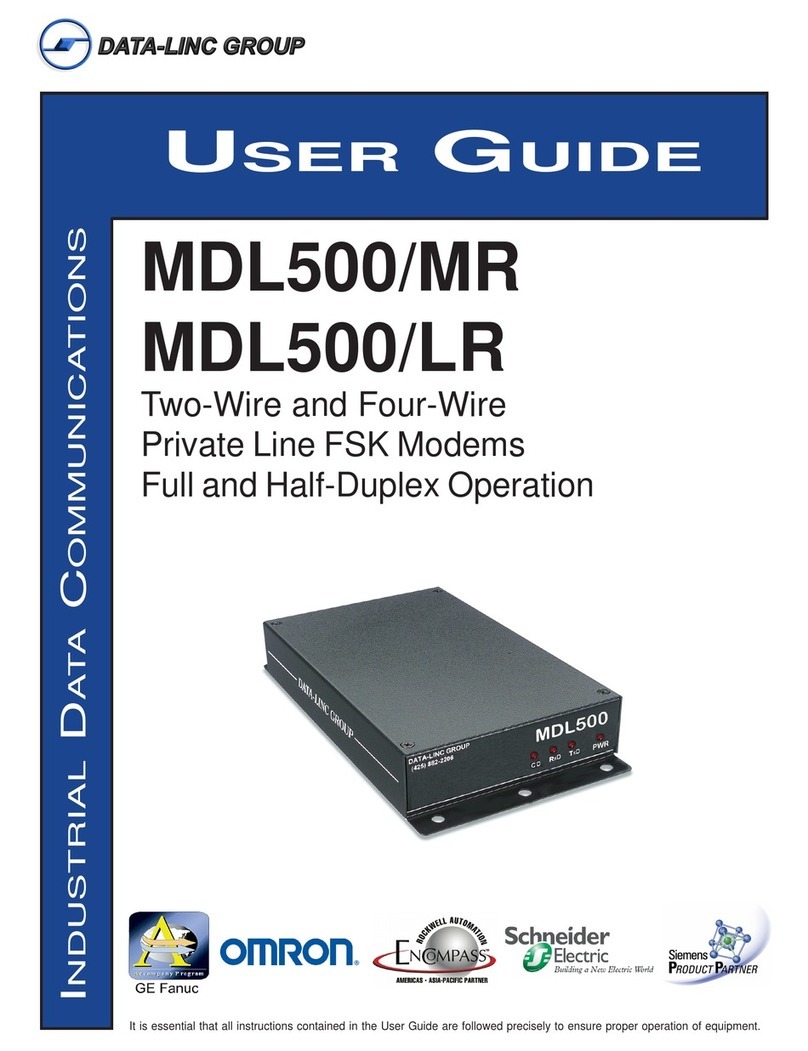
Data-Linc Group
Data-Linc Group MDL500/MR User manual

Data-Linc Group
Data-Linc Group FLC910E User manual
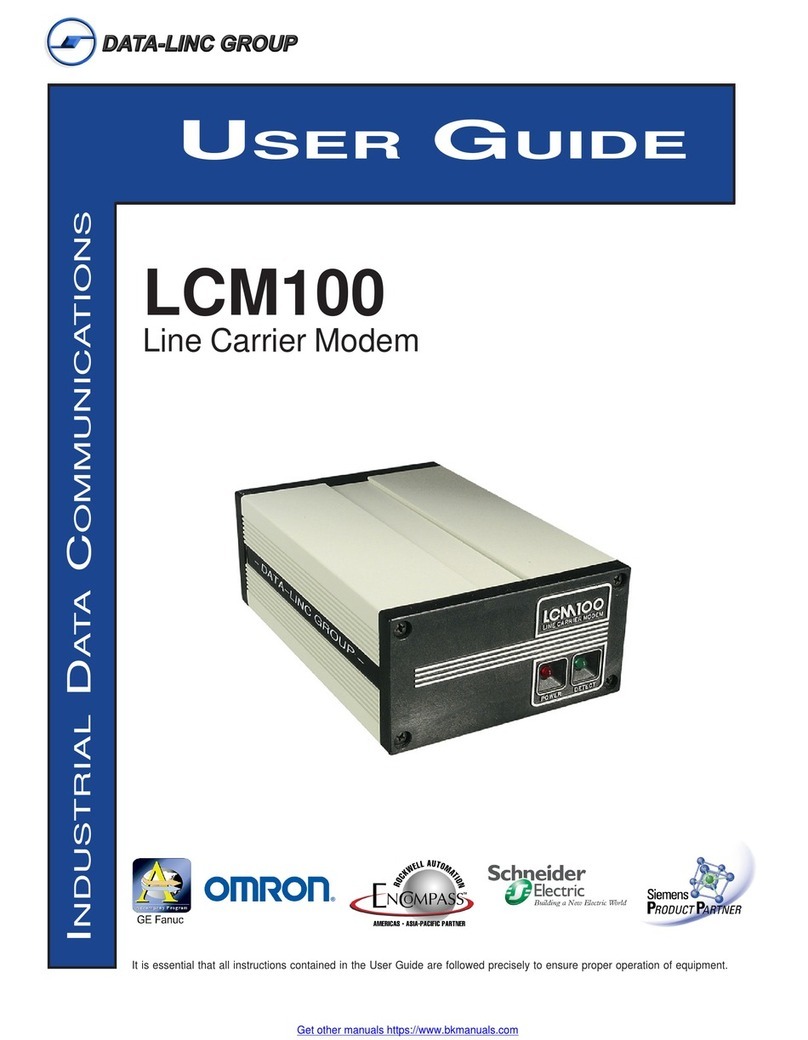
Data-Linc Group
Data-Linc Group LCM100 User manual
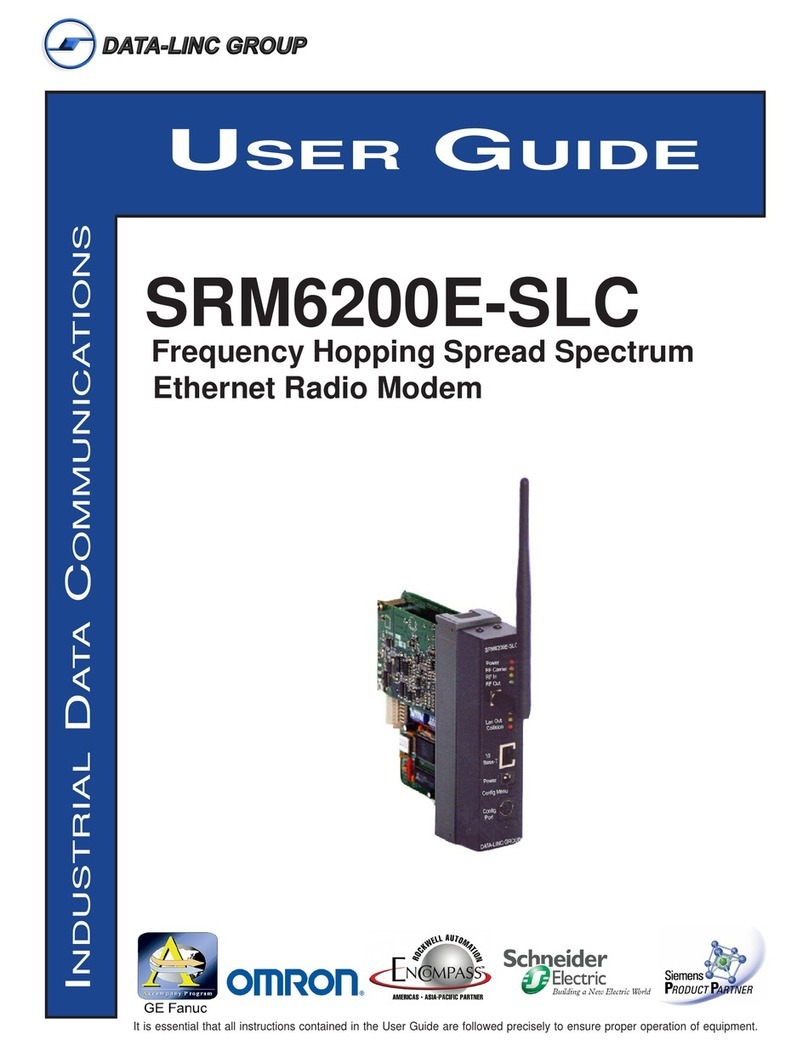
Data-Linc Group
Data-Linc Group SRM6200E-SLC User manual
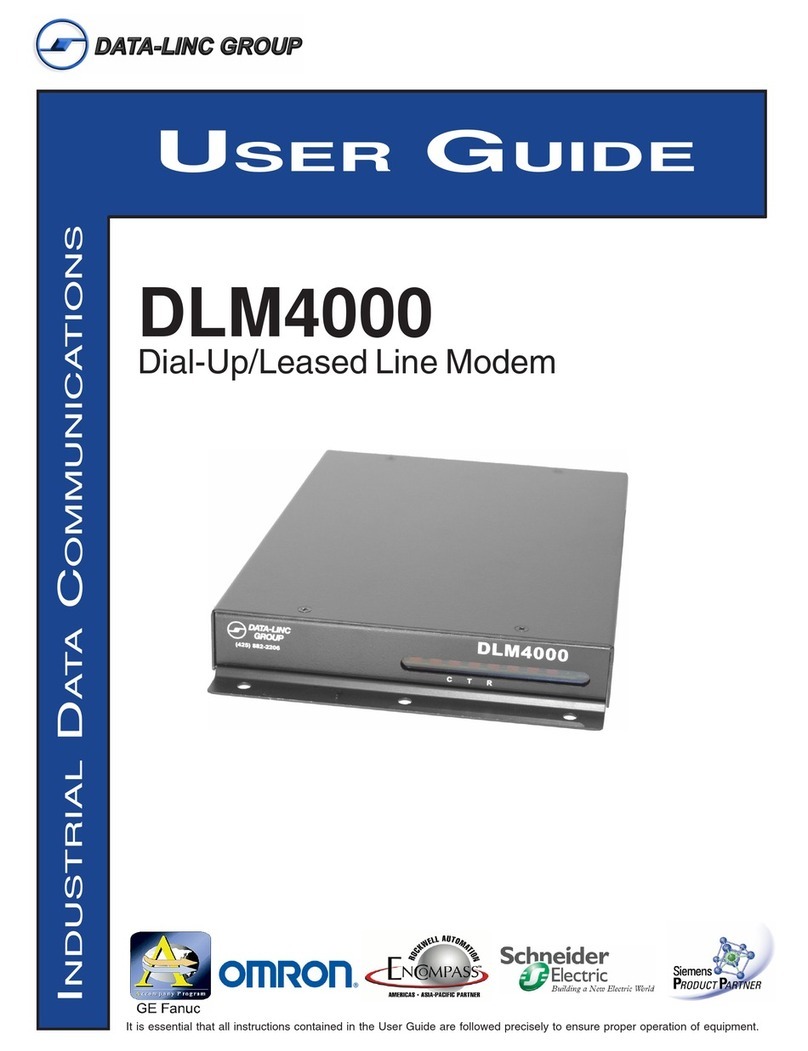
Data-Linc Group
Data-Linc Group DLM4000 User manual
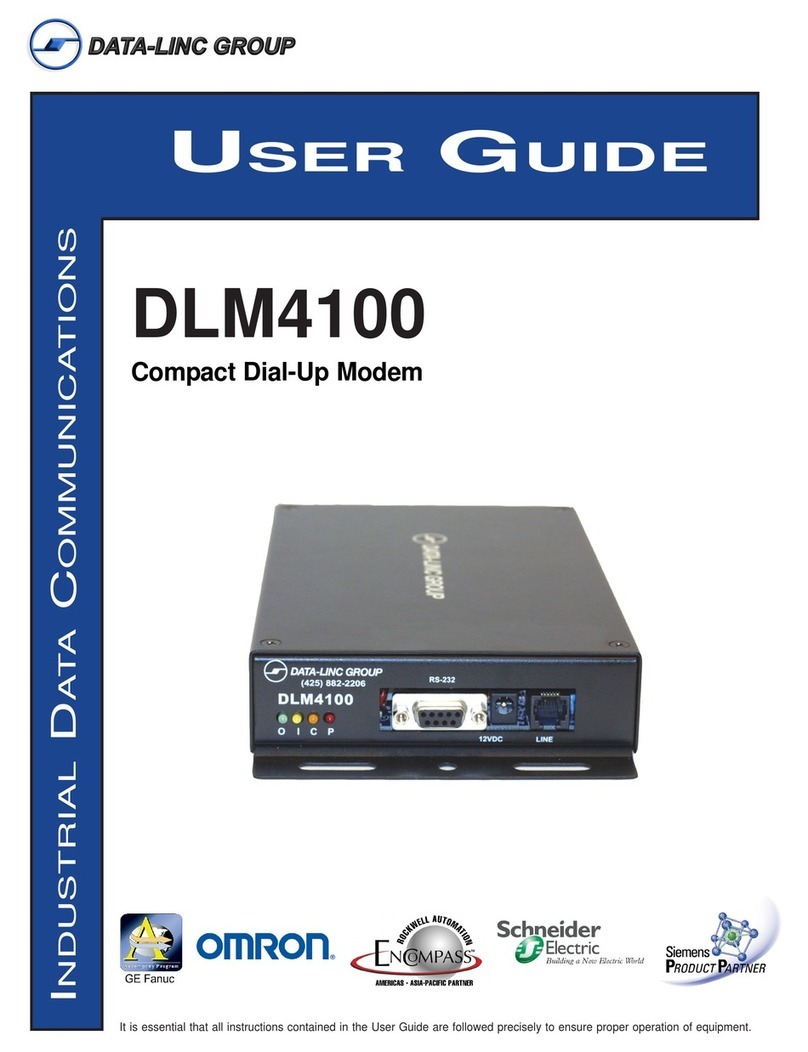
Data-Linc Group
Data-Linc Group DLM4100 User manual
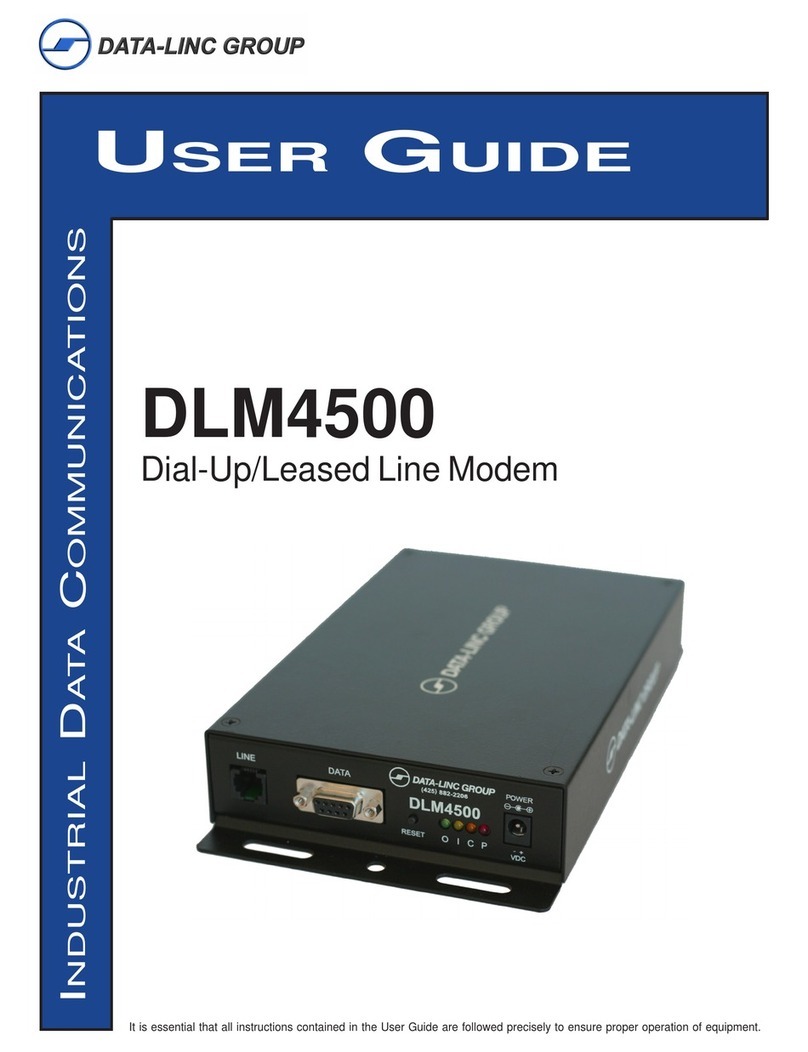
Data-Linc Group
Data-Linc Group DLM4500 User manual
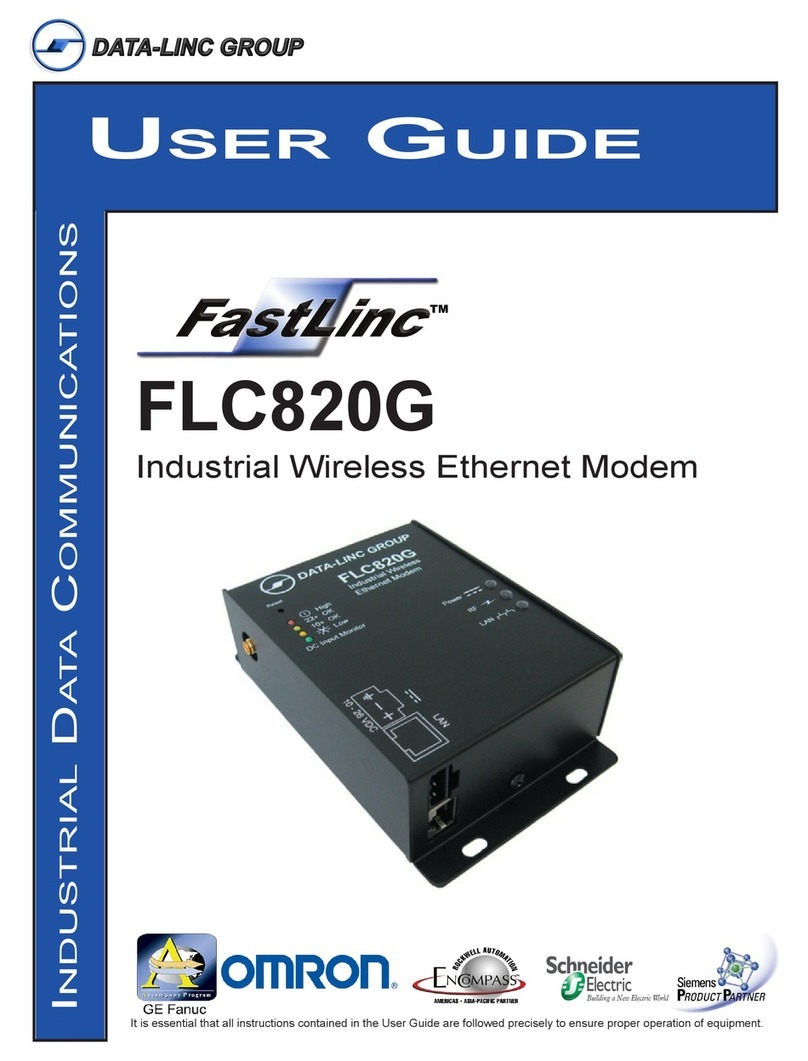
Data-Linc Group
Data-Linc Group FastLinc FLC820G User manual
